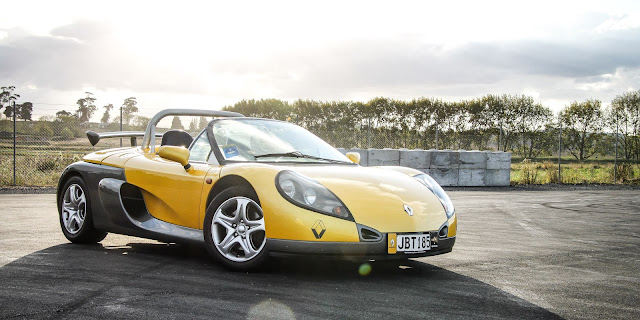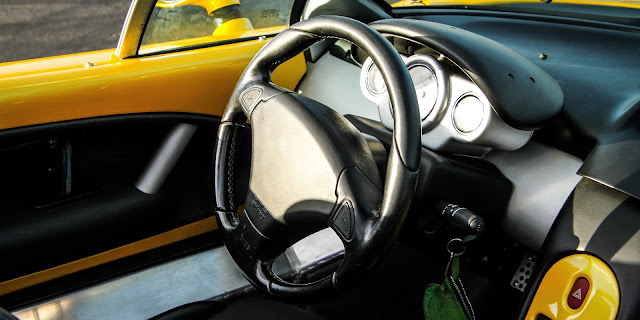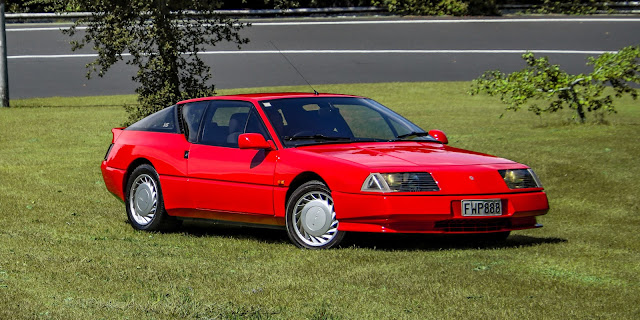Another month brings another weird addition to my articles, with this issue reviewing the Renault-Alpine GTA V6. I’ve been meaning to review this car since last year, but that’s when we got into our first New Zealand Level 4 lockdown, and I was forced to wait patiently. And though I did do other cars before I got to this one, I feel like the ones before can be treated as a good introduction to how my taste in cars are. Weird shapes, quirky features and obscurity is my forte, so let’s get on with it!
Mostly everyone knows what the Alpine brand is about, with the emergence of the new A110 back in 2017, but not many know that the brand actually started as just a racing team formed by Jean Rédélé meant to tune up old Renault 4CV’s. Originally called ‘Société des Automobiles Alpine SAS’. The name ‘Alpine’ actually referenced his wins in the ‘Coupe des Alpes’, but was a bit of a problem, as he did not realize that a year before in 1953, Sunbeam released a car called the Sunbeam Alpine…
A year after the marque was created, Rédélé created his first original car. Though it used the 4CV’s chassis and mechanicals, which was a rear engine RWD platform, the new and beautiful 2-door coupe was named the A106 and was vastly different from its Morris Minor-looking predecessor, looking more Renault Dauphine! Rédélé then one-upped himself and created the A108 with Michelotti’s help on styling, creating the now famous 2+2 Berlinette shape.
Taking over from the A108 was the iconic A110 Berlinette, which was really a facelift of the A108 with 2 extra headlights, revised styling, but still had the classic layout as well as competing in motorsport. In fact, the A110 was the first winner of WRC, however as the years moved on, other cars like the Lancia Stratos, which were built specifically for rally, soon made cars like the Alpine obsolete. The design of the A110 was clearly a 60’s feel, but it was built from 1961-1977, so at the end of its production, the international automotive design language had already moved away from long swaying lines to more rigid wedged shapes.

It was 1971 and the A110 was slowly becoming more and more obsolete. Enter the A310. It was unveiled while the A110 was still in production, as to get its audience familiarized with the new design, rather than allow for a huge gap in style. (Alpine skipped naming the new car as the A210, as they had made that a race car already.) It was a huge departure from the original design, but it was still spectacular to look at. 2 sets of triple headlights lined the front with its huge horizontal light casing, still retaining its sharp nose design. It must’ve been inspired by the headlight section of the Citroen SM (unveiled the previous year), and would probably go on to inspire cars like the NSU Trapeze (which came out in 1973 under Gruppo Bertone.) The rest of the car seemed like it was inspired by the 1970 Monteverdi Hai, with similar styled windows, and a huge rear window (like the 1968 Lamborghini Espada) for where the rear-mounted engine was.
The A310 would then go on to get a full update in 1976 where its styling was more modernized, with smaller headlight sections, larger haunches and the introduction of the famous PRV V6. (We’ve talked a lot about this engine in my other reviews: the Clio V6, Avantime and Sport Spider). (The later A310 is also my favourite Alpine car, as when it participated in Group 4, it got a homologated road car, which kept its rally-bred styling, big wing and excessive head/fog-lights.)
As the A310 phased out of production in 1985, the car we’re reviewing today emerged. Rather than following nomenclature tradition and going with A410 or A510, it was named the GTA (Grand Tourisme Alpine). However, rather than being named the ‘Alpine GTA’ in European markets, it was renamed to the Renault GTA, due to Chrysler’s Talbot/Sunbeam marque already using the ‘Alpine’ name at the time. In terms of design, it was a linear evolution from its predecessors, with the same overall wedge silhouette, sharp nose, sharp headlights, the 3-segment parallelogram-like side windows, huge rear engine bay window, and fender haunches (albeit less pronounced). This creation was the work of Yves Legal, who also designed the iconic Renault 5 Turbo. Now I don’t normally say this, but in this case, I prefer the GTA over the A610, simply because the pop up headlights on the latter look a tad bit out of place…
Aerodynamics were enhanced by its rounded wedge shape, rather than the direct angles that were approached in the A310. Just like other cars of the era, minimizing drag was achieved by placing the front grill at the bottom of the car like a stingray’s mouth, scooping up the air and adding more downforce and keeping the lighter front down, as the engine is in the rear. And because of the rear-wheel drive layout, a little lip spoiler with forward facing vents helped with lateral downforce and engine bay cooling. Now, rather than big side scoops like other mid/rear engine cars, the GTA featured slim slats on the rear portion of the windows like the slats on the Lamborghini Miura.

For cooling of the brake rotors the wheels are aerodynamically-designed turbofans to suck in cold air and push hot air out of its one-way facing flaps around the rim, which were used in Le Mans, Group B and DTM race cars of the time. Even small details like the wing mirrors were inspired after airplane aerofoils and its haunches are smooth bulges like its competition, the E30-generation M3, rather than the squared off arches like another rival competitor, the Audi Sport Quattro. This decreased its drag coefficient down to 0.28, making it the most aerodynamic production car in its class. (The turbo model of the GTA had a higher drag coefficient at 0.30 due to more intakes for the added turbochargers and larger tires for the added power.)
The whole car was built much like Tamiya plastic scale models we know today, with the body of the GTA was actually molded out of many separate smaller panels, rather than one whole shape like the previous Alpines, and was glued together to form the full vehicle. This minimized production time from 130 hours down to a mere 77 hours. And because it was made from polyester plastics and fiberglass, this made the car considerably lighter and faster than many of its competitors like the Porsche 944 and the aforementioned E30 M3 and Audi Sport Quattro for example. The backbone of the car was equally unique, with the drivetrain mounted on a completely different subframe, making for an easy 2 hour removal. The frame was also mounted 40mm forwards allowing for more forward weight distribution, keeping the front down.

Much like the exterior, the inside of the car looked equally awesome, with polygonal vectors and squared off dials, buttons and switches. And just like other sports cars of the era, from where the driver is sitting, all the switches are easy to reach, closely surrounding the dash like a fighter jet’s cockpit. All major dials and buttons were done in red, while entertainment features were finished off in white. This, coupled with the air conditioning vent slats made it look very unique among other cars of the decade! The space inside also increased, allowing for full adults to actually sit on the rear row with much squeeze. Now, the front two seats in this particular car aren’t actually factory. They’re Recaro seats from a Daihatsu Charade De Tomaso, believe it or not!

Power came from a naturally aspirated 2.9L PRV Z6W V6 engine which was an updated version of the 2.7L PRV V6 that was used in the A310 V6. Other cars that used the Z6W included the DMC DeLorean, the Lancia Thema, the Venturi 160/260 cars, and also the Peugeot Oxia concept supercar. The GTA had 158hp, and was enough to send the car spinning if put under enough acceleration through corners, so drivers are warned to enter corners slower, and power out of them to counter this. (Just like a Porsche 911.) The gearbox was also an updated version of the Renault 30-based model that was in the Alpine A310 as well, but the 4th and 5th gears were modified to be a bit longer. The car actually had so much torque (207Nm) at the low end of the rev range (2750 rpm), meaning that you could cruise at a slow pace in 4th and not even feel the car judder. This performance meant that the 0-100 km/h came to 7.6 seconds, a top speed of 250 km/h and did a quarter mile in 16.0 seconds at 156 km/h.
Colour Time:
1986:
Red (Rouge), Titian Red (Rouge Titien), Stratos Blue (Bleu Stratos), Black (Noir), Silver Grey (Gris Argenté), Pearl White (Blanc Perle).
1987:
Titian Red was taken away, but Volcano Grey (Gris Volcan) was added.
1988:
This year, many more colours were added to the colours already in the lineup. This included Schoolboy Red (Rouge Écollète), Champagne Beige (Beige Champagne), Granite Green (Vert Granit), Marine Blue (Bleu Marine), Sports Blue (Bleu Sport), Alpine Blue (Bleu Alpin) and Gardenia White (Blanc Gardénia). Titian Red was added back, but was renamed Indian Red (Rouge Indien). Pearl White was discontinued.
1989:
In 1989, only 1 colour was added. Pearl White, but in a new shade, different from the Pearl White shade in 1986. Most of the other colours were renamed: Red was renamed Bright Red (Rouge Vif), Marine Blue renamed to Navy Blue (Bleu Marin), Granite Green renamed to Amber Grey (Gris Ambre) and Champagne Beige to just Beige. However, 1989 also added Special Order colours like: Cornelian Red (Rouge Cornaline), Vesuvius Red (Rouge Vésuve), Meteor Red (Rouge Météore), Sardinia Brown (Marron Sardaigne), Emerald (Émeraude), Atlantic Green (Vert Atlantique), Blue (Bleu), Manchurian Blue (Bleu Mandchourie), Iceland Blue (Bleu Islande), Titanium Grey (Gris Titane) and Carbon Grey (Gris Carbone).
1990:
All the colours of 1990 were the same as 1989’s colours, with the Special Order colours with no change. Only 1 colour was added as a limited edition special, and that was Scarlet (Écarlate).
Even though there were so many colours within the lineup, most of the GTA’s you see are Red and Black, as they are the only 2 no-extra-cost colour options.
Now that I’ve written about yet another weird vehicle, what will the next one be? Until next time!























